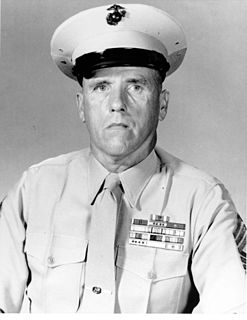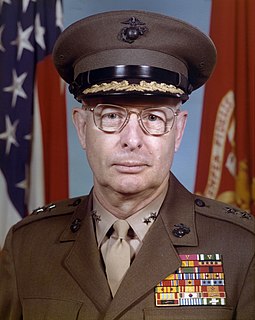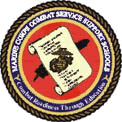
Marine Corps Base Camp Lejeune is a 246-square-mile (640 km2) United States military training facility in Jacksonville, North Carolina. Its 14 miles (23 km) of beaches make the base a major area for amphibious assault training, and its location between two deep-water ports allows for fast deployments. The main base is supplemented by six satellite facilities: Marine Corps Air Station New River, Camp Geiger, Stone Bay, Courthouse Bay, Camp Johnson, and the Greater Sandy Run Training Area. The Marine Corps port facility is in Beaufort, at the southern tip of Radio Island. It is military property but is occupied only during military port operations.
The School of Infantry (SOI) is the second stage of initial military training for enlisted United States Marines after recruit training. Since the initial training pipeline is divided between coasts, Marines from areas east of the Mississippi River usually graduate from MCRD Parris Island and move on to SOI at SOI East, while those from the western half of the nation attend MCRD San Diego and move on to SOI West at the Camp San Onofre area of Camp Pendleton in California. Female Marines are trained at both SOI East and SOI West. The School of Infantry's training mission ensures "Every Marine is, first and foremost, a Rifleman". At SOI, Marines with the Military Occupational Specialty of infantry are trained at the Infantry Training Battalion (ITB), while all non-infantry Marines are trained in basic infantry and combat skills at the Marine Combat Training Battalion. SOI marks a transition in the professional training of entry-level students from basically trained Marines to combat-ready Marines.

Thomas J. McHugh was a United States Marine who served as the 3rd Sergeant Major of the Marine Corps from June 29, 1962, to July 16, 1965.

Lewis G. Lee is a retired United States Marine who served as the 13th Sergeant Major of the Marine Corps from 1995 to 1999. He retired from active duty in 1999 after over 31 years of service. He was the last Sergeant Major of the Marine Corps to serve in combat in the Vietnam War.

Leland D. Crawford was a United States Marine who served as the 9th Sergeant Major of the Marine Corps from 1979 to 1983.

The Montford Point Marine Association (MPMA) is a nonprofit military veterans' organization, founded to memorialize the legacy of the first African Americans to serve in the United States Marine Corps. The first African American U.S. Marines were trained at Camp Montford Point, in Jacksonville, North Carolina, from 1942 to 1949.

Walter Keith Singleton was a United States Marine Corps sergeant who was awarded the Medal of Honor posthumously by President Lyndon B. Johnson, for his actions above and beyond the call of duty in Vietnam on March 24, 1967, during the Vietnam War.

James F. "Jim" Amos is a retired United States Marine Corps four-star general who served as the 35th Commandant of the Marine Corps. As a naval aviator, Amos commanded the 3rd Marine Aircraft Wing during the Iraq War in 2003 and 2006. He served as the 31st Assistant Commandant of the Marine Corps from 2008 to 2010, and was the first Marine Corps aviator to serve as commandant.
Camp Geiger is a United States Marine Corps base. Although not geographically connected, Camp Geiger is part of the Marine Corps Base Camp Lejeune complex, and is home to the United States Marine Corps School of Infantry East for all Marines recruited through the Eastern Recruiting Region. Located off U.S. Route 17 about 10 miles south of Camp Lejeune, it shares the main gate of Marine Corps Air Station New River. It trains approximately 20,000 Marines every year.

Sergeant Major Gilbert "Hashmark" Johnson was one of the first African Americans to enlist in the United States Marine Corps and one of the first African American drill instructors in the Marine Corps. Johnson was known as “Hashmark” because he had more service stripes than rank stripes. He retired in 1959 after 32 years of service in the U.S. armed forces, including 17 years as a Marine.

Edgar R. Huff was the first African-American in the United States Marine Corps to be promoted to the rank of sergeant major. He served in World War II, the Korean War and the Vietnam War.
The Camp Lejeune incident refers to the outbreak of hostilities between black and white enlisted Marines at an NCO Club near the United States Marine Corps's Camp Lejeune in North Carolina, on the evening of July 20, 1969. It left a total of 15 Marines injured, and one, Corporal Edward E. Blankston, dead. It was subsequently investigated by the military, and led to widespread changes in military race relations and policy.
Naval Medical Center Camp Lejeune is a Defense Health Agency-run facility that is located on Marine Corps Base Camp Lejeune in North Carolina, USA.
A School of Infantry provides training in weapons and infantry tactics to infantrymen of a nation's military forces.

The United States Marine Corps (USMC) is a desegregated force, made up of troops of all races working and fighting alongside each other. In 1776 and 1777, a dozen Black American Marines served in the American Revolutionary War, but from 1798 to 1942, the USMC followed a racially discriminatory policy of denying African Americans the opportunity to serve as Marines. For more than 140 years, the Marines recruited primarily European Americans and white Hispanics, along with a few Asian Americans.

The Beirut Memorial is a memorial to the 241 American peacekeepers—220 Marines, 18 sailors, and three soldiers—killed in the October 23, 1983 Beirut barracks bombing in Beirut, Lebanon. It is located outside the gate of Camp Gilbert H. Johnson, a satellite camp of Marine Corps Base Camp Lejeune, in Jacksonville, North Carolina. It is the site of an annual commemoration of the victims of the suicide attack that took their lives.

William George Joslyn was a decorated officer in the United States Marine Corps with the rank of major general. A veteran of three wars, Joslyn distinguished himself in the Korean War and rose to the rank of general during the Vietnam War. He completed his career as commanding general, 2nd Marine Division.

Herbert Lloyd Wilkerson was a United States Marine Corps major general. A veteran of three wars, he was most noted for his service as commanding officer, 1st Marine Regiment during Vietnam War and later as commanding general, 3rd Marine Division.

The 3d Antiaircraft Artillery Battalion (Composite) was an antiaircraft unit in the United States Marine Corps that served during World War II. The battalion was originally formed in 1943 as the 52d Defense Battalion, one of the first African American units in the Marine Corps. Its original mission was to provide air and coastal defense for advanced naval bases. During the war the battalion served as garrison forces on Roi-Namur, Majuro, and Guam. The battalion returned to Marine Corps Base Camp Lejeune, North Carolina after the war. It was the last of the defense battalions before it was re-designated as the 3d Antiaircraft Artillery Battalion in May 1946. The battalion was decommissioned on May 15, 1947.

The 51st Defense Battalion was an antiaircraft and coastal defense unit in the United States Marine Corps that served during World War II. The battalion was originally formed in August 1942 and was the first African American unit in the Marine Corps. Its original mission was to provide air and coastal defense for advanced naval bases. During the war the battalion served in the Ellice and Marshall Islands, in the Pacific Theater. The 51st returned to Marine Corps Base Camp Lejeune, North Carolina after the war and was decommissioned on January 31, 1946. To date, no other Marine Corps battalion has carried the lineage and honors of the 51st Defense Battalion.



















